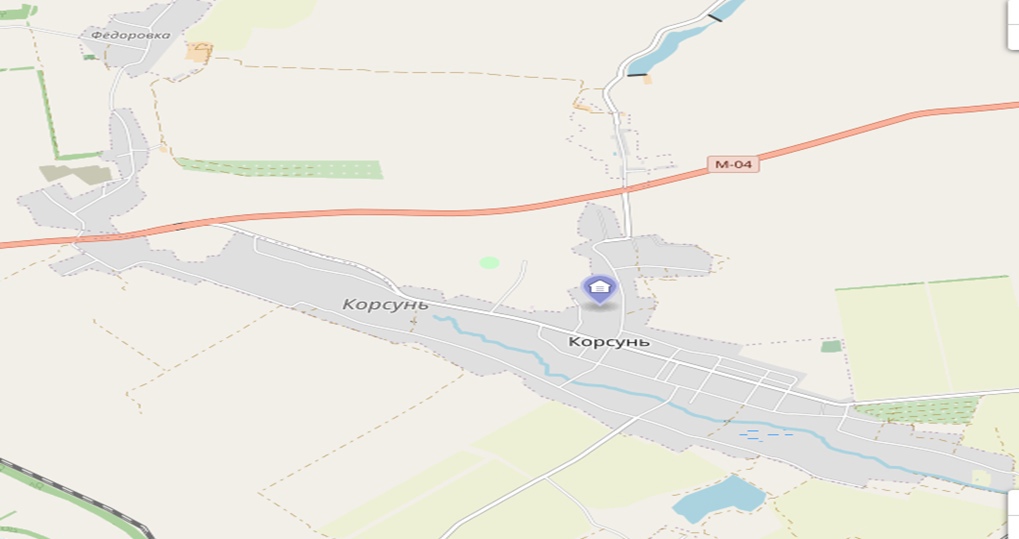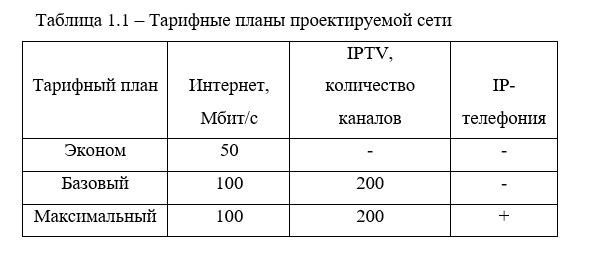Abstract on the topic of the final work
Content
- Introduction
- 1. Relevance of the topic
- 2. ANALYSIS OF THE DESIGN OBJECT
- 2.1 General characteristics of the object
- 2.2 Analysis of the existing network and their shortcomings
- 2.3 Information model of the designed network
- 2.4 Analysis of the existing network and their shortcomings
- 2.5 Purpose and objectives of the qualifying work
- Conclusions
- List of sources
Introduction
The rapid development of computer communication technologies leads to the introduction of new services on the market, among which one of the main ones is high-speed data transmission. For its implementation, it is necessary to use equipment more efficiently, but also to ensure security, throughput and quality. All these requirements are met by GePON technology, which will be used in the design of the network for Korsun. The telecommunications network of a communication provider acts as a design object in this work. Due to the low level of development of telecommunications in settlements with a small population, the task is to design a modern telecommunications network using digital equipment and fiber optic communication lines that allow the provision of both IP telephony services, Internet access and IP television services with high data transfer rate. To achieve the goal, it is necessary to solve the following tasks:
1. Analyze the provided infocommunication services and develop an information model of the network;
2. Perform an assessment of the traffic generated by subscribers;
3. To form requirements for the used network topologies and technologies, equipment and structural cabling system;
4. Develop a block diagram of the infocommunication network, as well as evaluate the performance of the developed network.
2.1 General characteristics of the object
The object of designing a multiservice network is the urban-type settlement of Korsun, which is shown in Figure 1, located 13 km from the city of Enakievo. The village covers an area of about 1.5 square kilometers. The number of inhabitants is about 3 thousand people. On the territory of the village there are 1 five-story residential building, 946 houses of the private sector, as well as the following institutions: an educational school of 1-3 levelsher, a kindergarten, a library, a two-story administrative center of the village council with a post office built into it. Topographic map of the village. Korsun is shown in Figure 1.1.
Figure 1.1 - Topographic map of the town. Korsun
The Internet provider "Perspektiva" operates in the village, which provides only an Internet connection with a maximum speed of 20 Mbps, which indicates the lack of a variety of tariffs and services.2.2 Analysis of the existing network and their shortcomings
Approximately 30% of the population use the Internet in this area. Since the quality and transmission speed of existing providers do not satisfy users, it becomes necessary to design a new modern wired network. The Internet is not the main task, as there is a demand for VoIP and IPTV services, which are poorly developed here. Provider Perspektiva LLC provides only Internet services. The maximum speed provided by competitive providers reached up to 20Mbps. The main advantages of the new projected network is the presence of a variety of services, so with GePON technologies not only high-quality high-speed Internet will be provided, but also the basic range of services that are needed in modern society for work and leisure. This list of services is displayed in clause 2.3. .
2.3 Information model of the designed network
For the population of the village. Korsun is expected to provide the following services:
– access to the Internet via fiber-optic lines at speeds from 50 Mbps to 100 Mbps for various groups of subscribers;
- IPTV (IPTV), which allows you to watch movies and TV programs up to 200 channels via an Internet connection;
– IP-telephony (VoIP), which provides the ability to make telephone calls using an Internet connection.
Consider each type of infocommunication services.
Access to Internet resources - access to Internet resources will be provided through the use of various specifications of modern data transfer technologies. It is assumed that the main transmission medium will be carried out via fiber-optic lines. For different groups of subscribers, only access speeds will differ.
IP-telephony is the general name of the means for ensuring the transmission of voice traffic over data networks. The main difference from traditional telephone networks is the transmission of a digital signal in an encoded form. The advantages over traditional telephony are that the provider himself is directly involved in the organization of voice communication, and this is much faster and in some cases cheaper. One of the most common G.711 codecs will be used to transmit the digital stream.
IPTV - digital television in data networks using the IP protocol. The main advantage of the latter is that there are actually no restrictions on the number of broadcast channels, but only the channel bandwidth is limited. The main type of traffic transmission is multicast - only one copy of the TV stream is transmitted from the server, which is delivered to all subscriber devices that have sent a request to receive it. An important point of multicast transmission is the fact that it does not involve sending subscriber requests to the broadcast server - they only reach the nearest router, which is currently receiving the required TV stream. The broadcast television stream is received from the satellite at the provider's video center and decompressed into streams with MPEG-2, MPEG-4 or HD compression standards. It is desirable to use MPEG-4. This video stream compression technology allows you to get lower streaming rates with the same video signal quality. IPTV is provided via an Internet cable, you can use a computer, set-top box, media player, SMART TV, and various mobile devices to view. Broadcasting is conducted in MPEG2 or MPEG4. To use IPTV, you need to install one of the special applications, or use the device's Internet browser. IPTV offers the user many channels and features without additional costs and restrictions. The viewer can set up IPTV exclusively for his needs, and more accurate statistics will allow in the future to produce exactly those programs and films that will be oriented directly to the interested viewer. Watching Full-HD 1080i/p HDTV movies can surpass the experience of visiting the most modern cinema. Based on the services provided, tariff plans have been developed (Table 1).

Figure 1.1 - Topographic map of the town. Korsun

Figure 1.2 - Network Information Model
2.4 Analysis of the existing network and their shortcomings
.Let's analyze the subscriber composition from the following considerations. Considering how low the speed of competitors was, then with proper marketing, as well as some promotions during the initial connection, you can count on, if not 60% connectivity, then close to this, so we will strictly accept it as such. Next, it is worth deciding on the percentage of connectivity by user category - 90% of the total number of subscribers for the Internet, 50% for IPTV, 30% for IP telephony. The number of network users is determined taking into account the number of private sector houses, 80 apartments in a five-story building, which includes 4 entrances with 4 apartments on each floor, as well as the coefficient of connection to the new network, which from the statistical data we will take equal to 0.6. Thus, the potential subscriber base of the network will be 615 users. The distribution of users by types of services is presented in Table 1.2.

Figure 1.3 - Distribution of users by type of service
2.5 Purpose and objectives of the qualifying work
Based on sections 1.1 - 1.3, the goal of qualification work can be formulated as improving the quality of information and communication services provided to residents of the village. Korsun city of Yenakiyevo due to the development of an infocommunication network To achieve this goal, it is necessary to solve the following tasks: to analyze the quantitative composition of subscribers:
1. Analyze the provided infocommunication services and synthesize the network information model; 2. Evaluate the traffic generated by subscribers; 3. Form requirements for the network topologies and technologies used; 4. Form requirements for equipment and structural cabling; 5. Develop a block diagram of the infocommunication network, as well as evaluate the performance of the developed infocommunication network.Conclusions
An infocommunication structure for the conditions of the town was chosen as an object. Korsun, Enakievo. The number of residents is about 3.5 thousand. On the territory at the moment, the village. Korsun, two Internet providers provide their services that provide only Internet services. Therefore, it is necessary to develop a more advanced network using modern technologies. Services provided: IPTV, high-speed access to Internet resources (50 and 100 Mbps). Based on this, 3 categories of subscribers were formed: "Category 1", "Category 2", "Category 3". This will be taken into account when evaluating the traffic generated by users. An approximate estimate of the number of users for each of the services was made: they make up 90% of the total number of subscribers for the Internet, 50% for IPTV, 30% for IP-telephony. Section 1.4 provides an analysis of the number of users. Thus, the potential subscriber base of the network will be 615 users. For the rational placement and use of equipment in the network, 3 zones (network nodes) are allocated with the following number of subscribers: 187, 210 and 218.
List of sources
- Degtyarenko I.V. Methodological recommendations for the course project on the course "Design of systems of telecommunication networks" for students of correspondence courses in the specialty 11.03.02 "Telecommunication systems and networks" /
- Cisco hardware. [Electronic resource] / Access mode: http://cisco.com.ua/router
- Chernyshev N.N. Chernyshev - Donetsk: DonNTU, 2016. - 24 p.
- Hopcroft, J. Introduction to Theoryyu automata, languages and computing / D. Hopcroft, R. Motwani, D. Ulman. - M .: Publishing house "Williams", 2002. - 528 p.
- Fiber to "business" - FTTBusiness. [Electronic resource] / Sergey Putrov - 2009. - Access mode: http://www.teralink.ru/?do=sprod1&id=255.
- Equipment for communication networks: General information about FTTX [Electronic resource] / UKRKOM Line - 2012. - Access mode: http://ukrcomline.com.ua/ru/ fttx/fttx/
- . Optical communication lines. [Electronic resource] / "Odeskabel" - 2012. - Access mode: http://www.odeskabel.com/vok-rus/index.php?option=com_content&task=view&id=8&Itemid=22
- Gigabit Ethernet technology [Electronic resource] / Access mode: https://ru.wikipedia.org/wiki/Gigabit_Ethernet.
- Olifer VG Computer networks. Principles, technologies, protocols: A textbook for universities. 3rd ed. / N. A. Olifer. – Peter, 2009.
- Architecture of optical access networks FTTH (Fiber-to-the-Home) [Electronic resource] / Access mode: http://fibertool.ru/news/kommentarii-spetsialista /fiber-to-the-home
- Zingerenko A.M. Multichannel communication systems: [textbook] / A.M. Zingerenko, N.N. Baeva, M.S. Tveretsky. - M .: Communication, 1980.
- Grodnev I.I. Fiber-optic communication lines / I.I. Grodnev. - M .: Radio and communication, 1990
- Butusov M.M. Fiber-optic transmission systems / M.M. Butusov, S.M. Wernick. - M .: Radio and communication, 1992
- Grodnev I.I. Optical cables: Designs, characteristics, production and application / I.I. Grodnev. - M .: Radio and communication, 1991.
- Rudov Yu.K. High-speed fiber-optic systems for trunk communication lines / Yu.K. Rudov, I.A. Lukin, M.I. Belyakov. – .
- Polyakov A.K. Languages VHDL and VERILOG in the design of digital equipment / A.K. Polyakov. – M.: SOLON-Press, 2003. – 320 p.
- Verbovetsky A.A. Fundamentals of designing digital optoelectronic communication systems / A.A. Verbovetsky. - M.: Radio and communication, 2000. - 160 p.
- Teumin I.I. Optical communication waveguides / I.I. Teumin. - M.: Communication, 1998. - 240 p.
- Elyon G. Fiber optics in communication systems / G. Elyon, H. Elyon. - M .: Mir, 1981. - 198 p.
- On the approval of the Model Regulations on the labor protection service [Electronic resource]: adopted by Decree No. 354 of August 27, 2015 / DPR. – Electron. Dan. (1 file: 151 Kb). – Donetsk: [b. and.], 2015. - System. requirements: Acrobat Reader.
- . On the approval of the Civil Defense Regulations [Electronic resource]: adopted by Decree No. 5-10 of 04/09/2015 / DPR. – Electron. Dan. (1 file: 399 Kb). – Donetsk: [b. and.], 2015. - System. requirements: Acrobat Reader.
- On labor protection [Electronic resource]: Law of the Donetsk People's Republic No. 31-INS of 03 April. 2015: active ed. // Official website of the People's Council of the Donetsk People's Republic. – Electron. Dan. - Donetsk, 2019. - Access mode: https://dnrsovet.su/zakon-dnr-ob-ohrane-truda/. - Zagl. from the screen.
- Barkalov A.A. Model-based approach to the development of CAD control automata / A.A. Barkalov, I.Ya. Zeleneva, S.A. Kovalev, A.A. Gritsenko // Proceedings of the Fifth International Scientific and Practical Seminar "Practice and prospects for the development of partnerships in the field of higher education." - Donetsk-Taganrog, 2006. - Volume 1. - P. 38-43.
- Kovalev S.A. Approach to the unification of the process of synthesis of MPA Moore for FPGA / S.A. Kovalev, I.Ya. Zeleneva, E.R. Tatolov // Proceedings of the Twelfth International Scientific and Practical Seminar "Practice and prospects for the development of partnerships in the field of higher education." - Donetsk-Taganrog, 2011. - Volume 2. - P. 45-48
- Barkalov A.A. Design and implementation of digital control systems using MDA / A.A. Barkalov, I.Ya. Zeleneva, A.A. Gritsenko // Proceedings of the III Scientific and Practical Conference "Donbas-2020: Science and Technology - Manufacturing". - Donetsk, 2006. - S. 463-467. .

